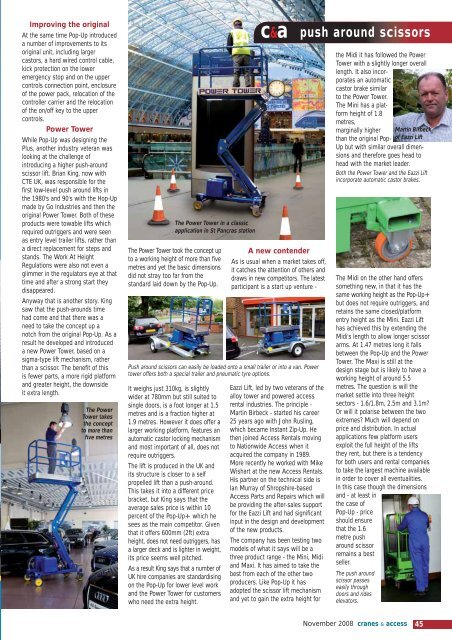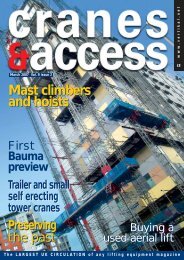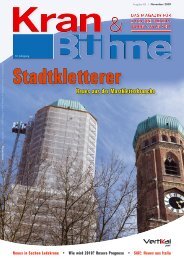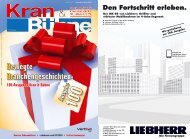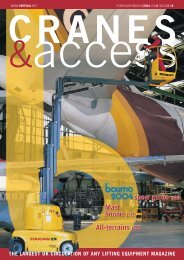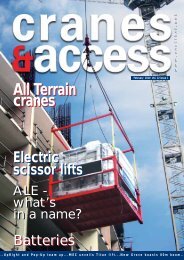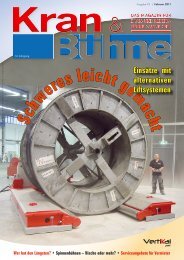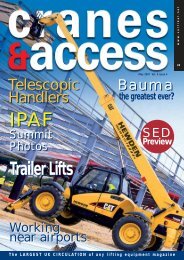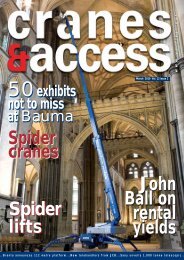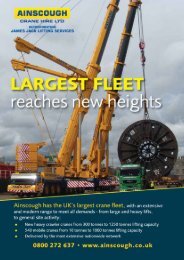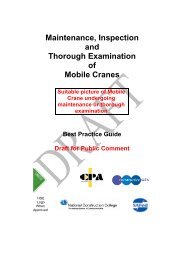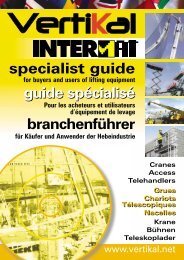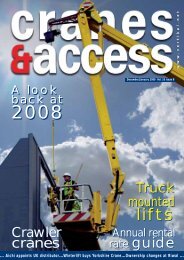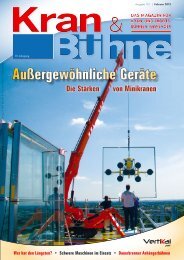Create successful ePaper yourself
Turn your PDF publications into a flip-book with our unique Google optimized e-Paper software.
Improving the original<br />
At the same time Pop-Up introduced<br />
a number of improvements to its<br />
original unit, including larger<br />
castors, a hard wired control cable,<br />
kick protection on the lower<br />
emergency stop and on the upper<br />
controls connection point, enclosure<br />
of the power pack, relocation of the<br />
controller carrier and the relocation<br />
of the on/off key to the upper<br />
controls.<br />
Power Tower<br />
While Pop-Up was designing the<br />
Plus, another industry veteran was<br />
looking at the challenge of<br />
introducing a higher push-around<br />
scissor lift. Brian King, now with<br />
CTE UK, was responsible for the<br />
first low-level push around lifts in<br />
the 1980's and 90's with the Hop-Up<br />
made by Go Industries and then the<br />
original Power Tower. Both of these<br />
products were towable lifts which<br />
required outriggers and were seen<br />
as entry level trailer lifts, rather than<br />
a direct replacement for steps and<br />
stands. The Work At Height<br />
Regulations were also not even a<br />
glimmer in the regulators eye at that<br />
time and after a strong start they<br />
disappeared.<br />
Anyway that is another story. King<br />
saw that the push-arounds time<br />
had come and that there was a<br />
need to take the concept up a<br />
notch from the original Pop-Up. As a<br />
result he developed and introduced<br />
a new Power Tower, based on a<br />
sigma-type lift mechanism, rather<br />
than a scissor. The benefit of this<br />
is fewer parts, a more rigid platform<br />
and greater height, the downside<br />
it extra length.<br />
The Power<br />
Tower takes<br />
the concept<br />
to more than<br />
five metres<br />
The Power Tower in a classic<br />
application in St Pancras station<br />
The Power Tower took the concept up<br />
to a working height of more than five<br />
metres and yet the basic dimensions<br />
did not stray too far from the<br />
standard laid down by the Pop-Up.<br />
c&a<br />
A new contender<br />
As is usual when a market takes off,<br />
it catches the attention of others and<br />
draws in new competitors. The latest<br />
participant is a start up venture -<br />
Push around scissors can easily be loaded onto a small trailer or into a van. Power<br />
tower offers both a special trailer and pneumatic tyre options.<br />
It weighs just 310kg, is slightly<br />
wider at 780mm but still suited to<br />
single doors, is a foot longer at 1.5<br />
metres and is a fraction higher at<br />
1.9 metres. However it does offer a<br />
larger working platform, features an<br />
automatic castor locking mechanism<br />
and most important of all, does not<br />
require outriggers.<br />
The lift is produced in the UK and<br />
its structure is closer to a self<br />
propelled lift than a push-around.<br />
This takes it into a different price<br />
bracket, but King says that the<br />
average sales price is within 10<br />
percent of the Pop-Up+ which he<br />
sees as the main competitor. Given<br />
that it offers 600mm (2ft) extra<br />
height, does not need outriggers, has<br />
a larger deck and is lighter in weight,<br />
its price seems well pitched.<br />
As a result King says that a number of<br />
UK hire companies are standardising<br />
on the Pop-Up for lower level work<br />
and the Power Tower for customers<br />
who need the extra height.<br />
Eazzi Lift, led by two veterans of the<br />
alloy tower and powered access<br />
rental industries. The principle -<br />
Martin Birbeck - started his career<br />
25 years ago with John Rusling,<br />
which became Instant Zip-Up. He<br />
then joined Access Rentals moving<br />
to Nationwide Access when it<br />
acquired the company in 1989.<br />
More recently he worked with Mike<br />
Wishart at the new Access Rentals.<br />
His partner on the technical side is<br />
Ian Murray of Shropshire-based<br />
Access Parts and Repairs which will<br />
be providing the after-sales support<br />
for the Eazzi Lift and had significant<br />
input in the design and development<br />
of the new products.<br />
The company has been testing two<br />
models of what it says will be a<br />
three product range - the Mini, Midi<br />
and Maxi. It has aimed to take the<br />
best from each of the other two<br />
producers. Like Pop-Up it has<br />
adopted the scissor lift mechanism<br />
and yet to gain the extra height for<br />
push around scissors<br />
the Midi it has followed the Power<br />
Tower with a slightly longer overall<br />
length. It also incorporates<br />
an automatic<br />
castor brake similar<br />
to the Power Tower.<br />
The Mini has a platform<br />
height of 1.8<br />
metres,<br />
marginally higher<br />
than the original Pop-<br />
Up but with similar overall dimensions<br />
and therefore goes head to<br />
head with the market leader.<br />
Both the Power Tower and the Eazzi Lift<br />
incorporate automatic castor brakes.<br />
The Midi on the other hand offers<br />
something new, in that it has the<br />
same working height as the Pop-Up+<br />
but does not require outriggers, and<br />
retains the same closed/platform<br />
entry height as the Mini. Eazzi Lift<br />
has achieved this by extending the<br />
Midi's length to allow longer scissor<br />
arms. At 1.47 metres long it falls<br />
between the Pop-Up and the Power<br />
Tower. The Maxi is still at the<br />
design stage but is likely to have a<br />
working height of around 5.5<br />
metres. The question is will the<br />
market settle into three height<br />
sectors - 1.6/1.8m, 2.5m and 3.1m?<br />
Or will it polarise between the two<br />
extremes? Much will depend on<br />
price and distribution. In actual<br />
applications few platform users<br />
exploit the full height of the lifts<br />
they rent, but there is a tendency<br />
for both users and rental companies<br />
to take the largest machine available<br />
in order to cover all eventualities.<br />
In this case though the dimensions<br />
and - at least in<br />
the case of<br />
Pop-Up - price<br />
should ensure<br />
that the 1.6<br />
metre push<br />
around scissor<br />
remains a best<br />
seller.<br />
The push around<br />
scissor passes<br />
easily through<br />
doors and rides<br />
elevators.<br />
Martin Birbeck<br />
of Eazzi Lift<br />
November 2008 cranes & access 45


